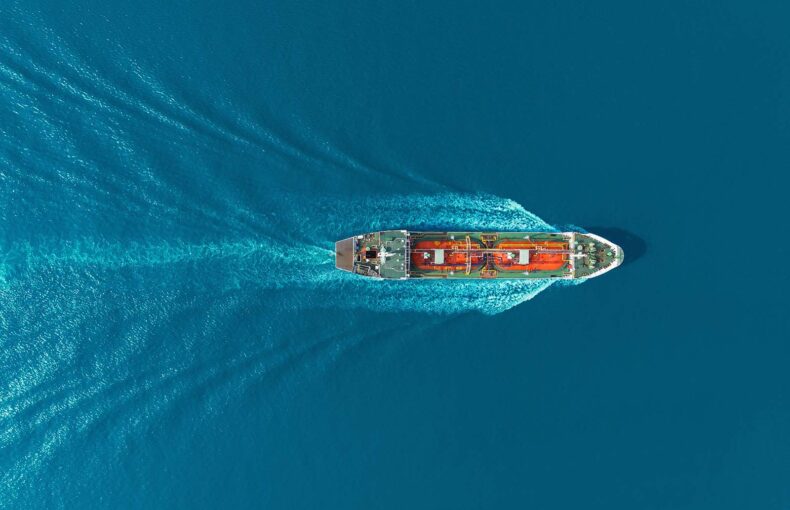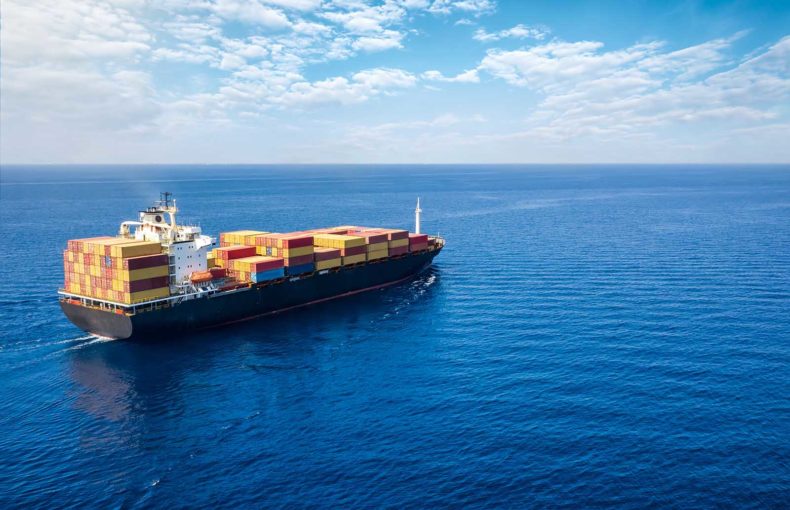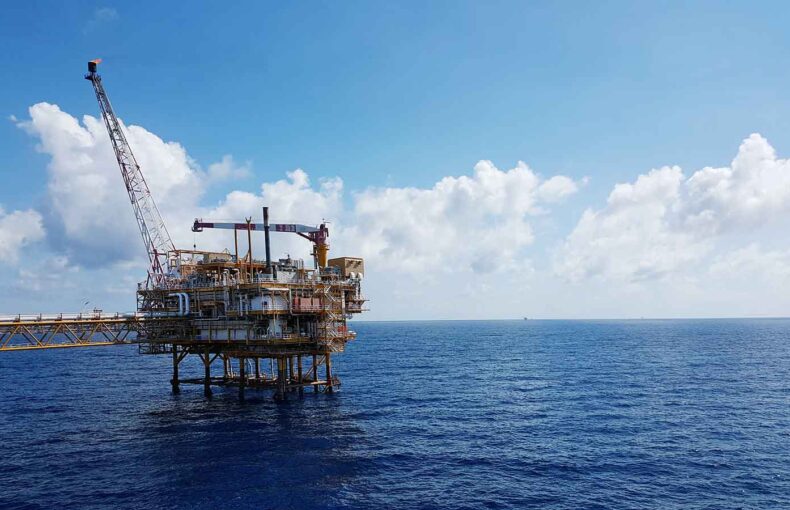How Jeddah Islamic Port is growing into its future
The port of Jeddah, which for centuries was a primary access point for people making the Hajj pilgrimage to Mecca, is the second-largest port in the Arab world and the region’s industrial transportation gateway.
Long known as the “bride of the Red Sea,” Jeddah has long been the commercial center of modern Saudi Arabia. It was a vital port on the ancient Silk Roads route that linked China to Europe, a precursor to the modern world’s global trade system. Today, over 65% of Saudi imports enter via the port, whose five terminals handle over 60 million tons of material annually. It is ranked the 37th busiest port in the world and, in the Middle East, is second only to Dubai’s Jebel Ali.
Given its position at the midpoint of the Red Sea, not only the port’s traffic has to be managed but also the steady flow of ships to and from the Suez Canal that connects the Red and Mediterranean seas. Thankfully, modern solutions like Enhanced Satellite AIS are available to help manage traffic on the world’s busiest waterways.
View Spire Maritime’s Enhanced Satellite AIS live demo
Not only does the port receive many ships that have just navigated or are approaching the canal, but it also plays an important support role. When the Ever Given container got stuck and shut down the Suez for six days in 2021, the Jeddah Islamic Port extended storage fee exemptions from 30 days to 60 days and expanded ship transfer and container offloading services to help alleviate the cascading situation.
“The initiative underscores Saudi Arabia’s commitment to mitigating the impact on global supply chains, in addition to affirming Saudi ports’ readiness to adapt to shifts in the international transport market and the associated challenges,” stated the Saudi Ports Authority (Mawani) when announcing the effort.
Jeddah Port Vessel Traffic, January 10th-17th 2022
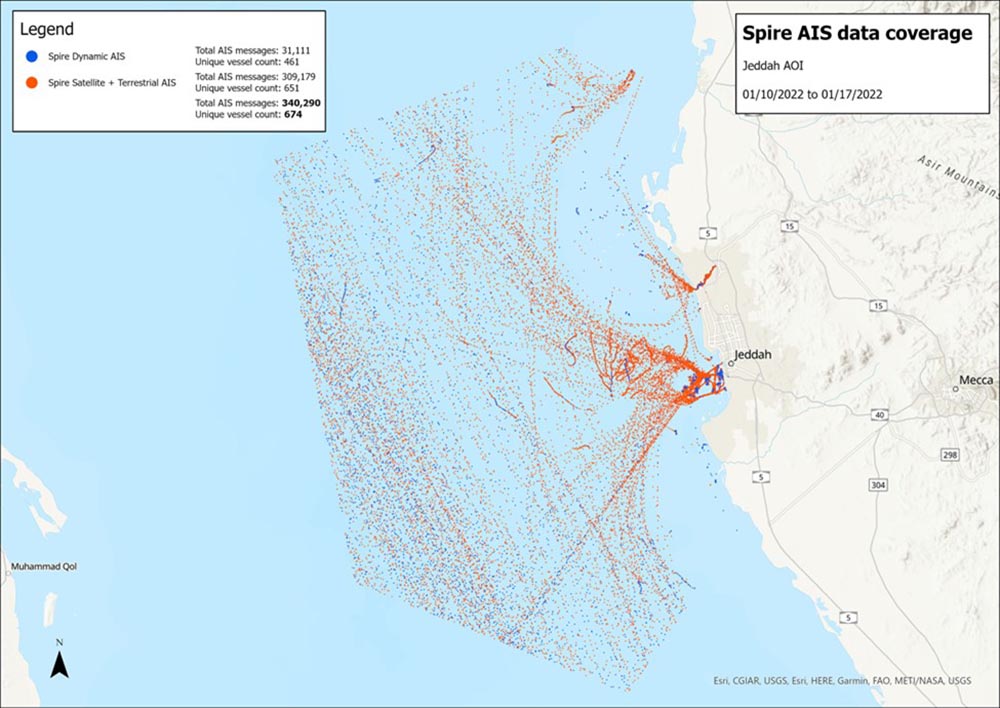
Source of data: Satellite, Terrestrial, Enhanced Satellite AIS
The modern city of Jeddah
Jeddah is now the second-largest city in Saudi Arabia, on top of being its commercial hub. As the gateway to humanity’s largest gathering, the city’s position in the travel and hospitality industry is assured. In 2019, prior to COVID-19, over 2.5 million people visited Mecca, though most transited through King Abdulaziz International Airport. But the port has slowly regained some of its role in the pilgrimage. This appears likely to continue, with Pakistan in 2020 resuming a Hajj-related ferry from Karachi that had been dormant for 26 years.
The level of transportation infrastructure needed to handle that many people, which also includes the Haramain High Speed Railway, has made Jeddah a natural economic hub. Warehousing and logistics are now pillars of the city’s economy. The Saudi Authority for Industrial Cities and Technology Zones (MODON), founded in 2001, is a government authority meant to encourage private sector investment and development via the establishment of designated “industrial cities.” These are dedicated economic zones meant to modernize and diversify the Saudi economy.
There are four now in Jeddah, traversing 105 million square meters, with a large proportion used for dry- and cold-storage warehouses and open yards. All are rooted in the powerful infrastructure reality that the city’s port represents.

Transformation into a regional infrastructure powerhouse
The investment into the infrastructure and economy of the Jeddah region is being matched at the port, which is not surprising since it is a vital aspect of the city’s growth. The management structure and modern operations of the Jeddah Islamic Port (JIP) were established in 1976. While it opened with just 10 berths, it now has 62, handling passengers, general cargo, livestock, bulk grains, 20-foot equivalent units (TEUs), and roll-on/roll-off (ro-ro) traffic.
There are two container terminals with a total capacity of 7.5 million TEUs, livestock berths that can handle 7 million animals annually, passenger terminals serving not only pilgrims but also cruise ship tourists, and the Jeddah Ship Repair Yard onsite. Expansive logistics parks onsite provide storage, including bulk grain, chilled and frozen cargo, and TEUs. The port handles the majority of goods imported into the Saudi Kingdom.
Port operations have been increasing steadily, even during the COVID-19 crisis, with 4.7 million TEUs handled in 2020, up 6.8% from 2019’s 4.3 million.
This increase in volume moved Jeddah Islamic Port up to the rank of 37 out of 100 top global ports, compared to 42nd place last year, according to Lloyd’s 2021 list of the top 100 ports.
As can be seen when looking at the six-month stats of port congestion, even with increased traffic and continued growth, the port has operated efficiently and kept average delays to the terminal well under 24 hours.
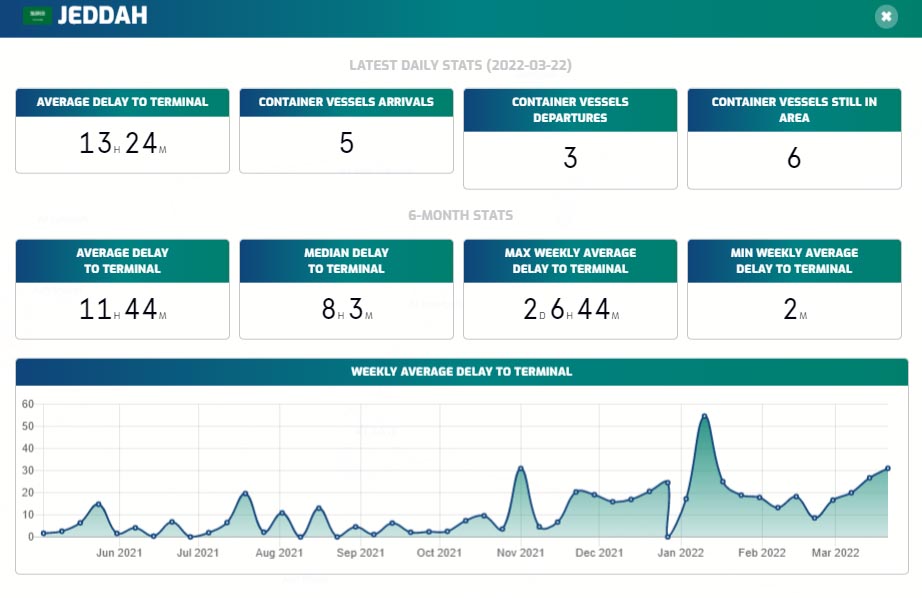
Visualizing the future
The steady growth of the Jeddah Islamic Port in recent decades will continue into the future. Several expansion projects are underway, all integrated into the Saudi Vision 2030 strategic framework. This blueprint was developed by the Saudi government to expand the nation’s economy beyond the oil sector via heavy investment into not only infrastructure but also education, health, technology, and tourism.
The move away from oil that has marked the port’s recent history, as the nearby King Fahad Industrial Port Yanbu has become the petrochemical hub for the Red Sea, fits perfectly with the Saudi Vision 2030 effort. The entire Jeddah region is seeing significant investment, not just the Jeddah Islamic Port.
Identified Vessel Types at Jeddah Port, January 10th-17th 2022
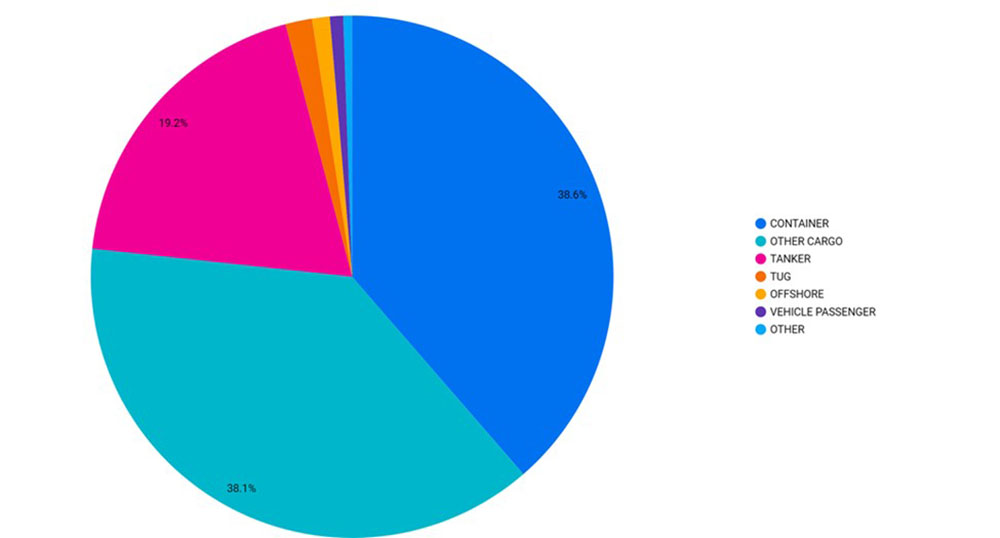
TEU Container Expansion
A major aspect of the port’s growth is enabling it to handle the world’s largest container ships, which can carry up to 26,000 TEUs. A joint effort began in 2019 between the port’s manager Mahwani and the multinational logistics company DP World and is scheduled to be completed in 2024.
Total TEU capacity at the facility will increase from 2.4 million to 4 million, which will reinforce the port’s dominant position in the Red Sea region. It includes deepening the harbor’s draft to 18 meters and extending its quay from 1,500 to 2,150 meters.
“We are working closely with Jeddah’s Islamic Port Authority and Mawani to continue strengthening the port’s position as a strategic trade hub, connecting Eastern and Western trade routes,” said DP’s Jeddah and Country Head of Saudi Arabia Mohammad Alshaikh. “Our strategy as a smart trade enabler is to modernise the facility, expand its capacity and diversify the range of smart logistics services on offer at the South Container Terminal. This will help in improving the quality of the service for our current customers and assist our efforts towards attracting new business to the port.”
Becoming a Cruise Ship Destination
In 2021, a former ferry terminal was transformed into the first cruise ship facility at the port, able to handle 2,500 passengers. It will host a cruise circuit that will also make calls in Jordan and Egypt as part of the quickly growing Red Sea cruise scene.
Obviously a vital piece of recreation and tourism infrastructure, the project is a partnership between the Mawani, the Saudi Cruise Company (Cruise Saudi), and the Swiss-Italian cruise line MSC Cruises. The completion of another state-of-the-art cruise terminal is planned by the end of the decade. The long-term goal is to have at least 1.5 million passenger-ship visitors transit through Saudi Arabia annually. The Jeddah Islamic Port will be the cornerstone of the Kingdom’s cruise ship sector, which is expected to create 50,000 jobs.
CARGOES TOS+ Operations and Planning System (OPS)
Another exciting aspect of upgrades at the port includes automation. The foundation of this is CARGOES TOS+, an end-to-end terminal software solution to modernize port operations that incorporates machine learning, artificial intelligence, and IoT platforms. The system came online at the end of 2021 and included a complete interface with N4 (the system many ships use to generate stowage plans), the first time that the CARGOES TOS+ became operational with an N4 backend at DP World port. It is one part of a suite of smart-trade digital projects being developed in Saudi Arabia.
Significant Expansion of Logistical Support Facilities
The steady growth and diversification of the port operations are being matched with investments into logistical upgrades throughout the area. At the beginning of 2022, Mawani partnered with transportation and logistics firm Bahri on a project to create an onsite integrated logistics park that will encompass 95,436 square meters. The new capacity will include expanded insulated, dry reefer (refrigerated) containers, with additional maintenance, repair, cleaning, and storage services.
Abdullah Ali Aldubaikhi, the chief executive officer of Bahri, stated that by “leveraging Jeddah Islamic Port’s strategic location, this agreement will further expand Bahri’s import, transport, distribution, and storage capabilities and help the company raise the level of its services according to international standards.”
This project is in addition to a similar project announced in late 2021, in partnership with the Danish shipping company A. P. Moller–Maersk and its Maersk Saudi Arabia subsidiary, for a 205,000 square meter greenfield project.
Since Saudi Arabia is not only abundant in oil but sunlight as well, the logistical expansion will include a vast array of solar panels to power the facility, with much of the core machinery—forklifts, stackers, container handlers, and trucks—transitioning to electric. The long-term goal is for port operations to be carbon-neutral.
Part of a bigger plan
The next decade promises to be one of cutting-edge, spectacular growth for the Jeddah Islamic Port and the entire region for which it is so vital. Both its expansion as a cargo port and increasing importance as a cruise destination port are fundamental to Saudi economic planning.
“The continuing development of our national ports through public-private partnerships is a priority for us at Mawani as part of our long-term strategy to drive growth in Saudi Arabia’s ports sector and bolster the kingdom’s pre-eminent position as a global logistics hub connecting three continents as envisaged in Vision 2030,” said Mawani President Omar Hariri when announcing the current port expansion in partnership with DP World. “With its strong track record in successfully delivering on concession contracts and operating ports facilities, DP World Jeddah is a strategic partner for us in our efforts to further develop Jeddah Islamic Port. We are confident that the new expansion project will have a significant impact not only on the port but also the Kingdom’s economy and society.”
 Written by
Written by
